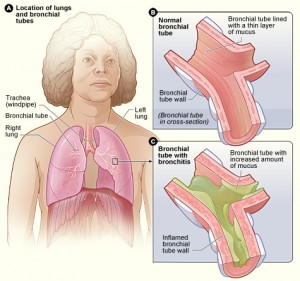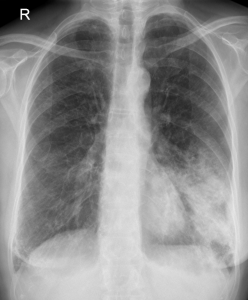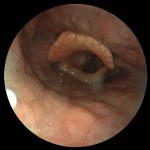Chronic Bronchitis — Symptoms and Treatment
Chronic bronchitis is characterized by expectoration for a period of more than three months, in more than two consecutive years. Chronic irritation caused by smoking promotes hyperplasia of mucus glands and increases the production of mucus. Central and peripheral airways are involved in the pathophysiology of the disease and it includes inflammation, oxidative stress, inhibited repair processes, and an imbalance of proteinases/anti- proteinases. This article will prepare you perfectly well for your next exam!
Table of Contents
- Definition and Background of Chronic Bronchitis
- Pathophysiology of Chronic Bronchitis
- Epidemiology of Chronic Bronchitis
- Presentation of Chronic Bronchitis
- Causes of Chronic Bronchitis
- Differential Diagnosis of Chronic Bronchitis
- Diagnosis of Chronic Bronchitis
- Management of Chronic Bronchitis
- Review Questions
- References
Are you more of a visual learner? Check out our online video lectures and start your course “Pulmonary Pathology” now for free!

Definition and Background of Chronic Bronchitis
Chronic bronchitis is defined as a chronic productive cough that lasts for at least three months, for two consecutive years in a patient in whom other causes of chronic cough have been excluded, such as bronchiectasis. Airflow limitation may precede the development of chronic bronchitis.Chronic bronchitis is considered one of the top conditions for which patients seek medical attention. The main characteristic of the condition is an inflammation of the bronchial tubes or bronchi, and the air passage extending from the trachea into the small airways and alveoli.
Pathophysiology of Chronic Bronchitis

Figure A shows the location of the lungs and bronchial tubes in the body. Figure B is an enlarged, detailed view of a normal bronchial tube. Figure C is an enlarged, detailed view of a bronchial tube with bronchitis. The tube is inflamed and contains more mucus than usual.
The attachment of the organism (Mycoplasma pneumoniae) to the respiratory mucosa results in bronchial irritation, leading to sloughing of the affected cells. Bronchopneumonia may develop if the inflammation extends downward to the bronchioles.
Epidemiology of Chronic Bronchitis
Approximately 8.7 million cases in the United States were diagnosed with chronic bronchitis during the year 2014, which is around 3.6 % of the population.The term bronchitis is commonly used to describe a self-limited nonspecific cough, which results in overdiagnosis of the condition, hence increasing its incidence even though many patients do not actually have bronchitis.
Acute bronchitis is usually diagnosed among children younger than 5 years of age; however, chronic bronchitis is more common among patients above the age of 50. The incidence appears to be higher in males than in females, and it usually affects people with low socioeconomic status.
Presentation of Chronic Bronchitis
Symptoms of chronic bronchitis
Complete thorough history of information regarding smoking and exposure to toxic substances is important. Patients presenting with bronchitis are usually overweight and cyanotic. The most important symptom in chronic bronchitis patients is a cough.Other symptoms may include:
- Sore throat
- Headache
- Extreme fatigue
- Muscle aches
- Runny nose
- Dyspnea and cyanosis may be observed
- Fever, nausea, vomiting, and diarrhea are rare in cases of chronic bronchitis
Signs of chronic bronchitis
Findings on physical examination may include:- Pharyngeal erythema
- Localized lymphadenopathy
- Rhinorrhea
- Coarse rhonchi
- Wheezes
- Use of accessory muscles
- Inspiratory stridor
- Heave along the left sternal border
- Clubbing or peripheral cyanosis may be observed in cases of cystic fibrosis
Causes of Chronic Bronchitis
Smoking and irritants
The most predominant cause for the development of chronic bronchitis is cigarette smoking. Other causes include exposure to irritants, such as chemicals, and pollution.Viral and bacterial infections in acute bronchitis
The most common viruses that may cause acute bronchitis include:- Influenza A and B
- Parainfluenza
- Respiratory syncytial virus
- Coronavirus
- Mycoplasma species
- Chlamydia pneumoniae
- Streptococcus pneumoniae
- Moraxella catarrhalis
- Haemophilus influenzae
Differential Diagnosis of Chronic Bronchitis
Other medical conditions to consider include the following:- Bacterial tracheitis
- Cough
- Exercise-induced asthma
- Influenza
- Cystic fibrosis
- Tonsillitis
- Retained foreign body
- Hyperreactive airway disease
- Acute sinusitis
- Occupational exposures
- Alpha1-Antitrypsin deficiency
- Asthma
- Bacterial pharyngitis
- Bronchiolitis
- Bronchiectasis
- Bronchitis
- Chronic sinusitis
- Chronic Obstructive Pulmonary Disease (COPD)
- Group A streptococcal infections
- Influenza
- Gastroesophageal reflux disease
- Viral pharyngitis
Diagnosis of Chronic Bronchitis
Patients with acute respiratory infection suffering from a cough are suspected to have bronchitis; however, bronchitis is considered a diagnosis of exclusion because there are many other serious respiratory diseases that may cause a similar picture.Chronic Obstructive Asthma: Atopic asthma since childhood plus heavy smokers in their 20s-30s could present with a combination of COPD+ Asthma which needs to be distinguished for the purposes of clinical management.
Chronic bronchitis: These patients fulfill the definition of 3 months of a productive cough over successive 2-year span with normal PFTs not considered to be COPD.
Blood and microbiology tests in chronic bronchitis
- Complete blood count with a differential is obtained
- Bacterial infections can be distinguished from non-bacterial infections using procalcitonin levels, which helps guide therapy and reduce the use of antibiotics.
- It may be useful to do influenza tests. However, serologic tests for atypical pneumonia are not suggested.
- If a cough is persistent, it might be helpful to use sputum cytology.
Imaging studies in chronic bronchitis
Patients with physical findings suggestive of pneumonia should have chest radiographs. However, elderly patients may not have any signs of pneumonia, but still they need chest radiographs to rule out pneumonia.
Image: “Pneumonia in chest X-ray” by Hellerhoff. License: CC BY-SA 3.0

Image: “Normal Epiglottis” by Med Chaos. License: CC BY-SA 3.0
Epiglottitis can be excluded using laryngoscopy.
Cultures
Cultures are obtained for Mycoplasma pneumoniae, Bordetella pertussis, and influenza virus. In cases of bacterial super-infection, it might be helpful to use blood cultures.Others
- Characteristic findings found in the small airways in chronic obstructive pulmonary disease (COPD) include mucosal and submucosal inflammatory cells, edema, increased smooth muscle, intra-luminal mucous plugs, peribronchial fibrosis, and goblet cell hyperplasia.
- Patients suffering from bronchitis usually have significant bronchospasm with a large reduction in forced expiratory volume in one second (FEV1). Spirometry may be useful in these patients.
Management of Chronic Bronchitis
Management of bronchitis focuses on the elimination of the symptoms. A combination of drugs may be prescribed to open obstructed bronchial airways and thin obstructive mucus making it easily coughed. Bed rest is recommended for these patients and adequate oxygenation should be ensured.It is important to avoid cigarette smoking and other environmental irritants to control cough and sputum production in patients with chronic bronchitis.
Symptomatic treatment of chronic bronchitis
- It is recommendable to use central cough suppressants such as codeine for short-term symptomatic relief in patients suffering from acute or chronic bronchitis.
- Symptoms such as dyspnea, bronchospasm, and chronic cough may be controlled with beta-agonists such as theophylline and ipratropium bromide.
- Patients suffering from underlying lung diseases that present with a cough and a wheeze may benefit from beta2-agonist bronchodilators.
- Pain and other constitutional symptoms of acute bronchitis may be treated using non- steroidal anti-inflammatory drugs (NSAIDS).
- Mucolytics may be used to reduce acute exacerbations.
Antibiotic therapy of chronic bronchitis
The use of antibiotics is recommended in patients suffering from acute exacerbations. However, it is not recommended if there is no risk of serious complications. Elderly patients with an acute cough and a history of hospitalization in the past year, and also have congestive heart failure or diabetes mellitus, or are receiving steroids may need antibiotic therapy.Influenza vaccination
The risk of upper respiratory tract infections is reduced with the use influenza vaccine, which results in a reduction of the incidence of acute bacterial bronchitis.Zinc
Most studies have shown that the use of zinc is beneficial against influenza A.Long-term monitoring in chronic bronchitis
- If symptoms worsen, such as high fever, shortness of breath, persistent cough, and vomiting; then an alternative diagnosis should be considered.
- Further investigations are recommended in cases of symptoms recurrence (more than 3 episodes a year).
Review Questions
The answers are below the references.1. A 66-year-old male patient, who was a smoker, died of chronic bronchitis. His medical history is not significant for other medical problems or conditions. Which of the following is the least to be observed in the autopsy of his lungs?
- Granulomatous inflammation
- Mucous gland enlargement
- Patchy squamous metaplasia
- Thickened bronchial walls
- Neutrophil infiltration
- Prior lung radiation
- Emphysema
- Asymptomatic asthma
- Silicosis
- Coal worker’s pneumonitis
- Increased arterial blood pH
- Increased compliance of the right ventricle
- Decreased arterial carbon dioxide content
- Increased arterial resistance in the lungs
- Increased cerebral vascular resistance
Comentários
Enviar um comentário